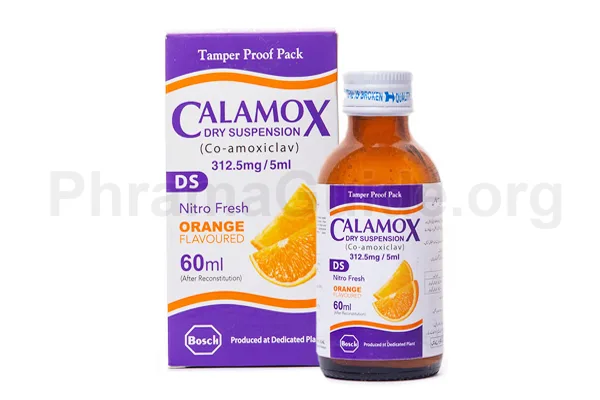Calamox syrup is a broad-spectrum antibiotic, primarily used to treat various bacterial infections including resistant infection to other antibiotics. It is mostly recommended for children and adults where a low dose of medicine is needed. The following are some common uses of Calamox Syrup:
- Respiratory Tract Infections: Calamox syrup is often prescribed to treat respiratory tract infections, such as bronchitis and pneumonia. It can help eradicate the bacteria responsible for these infections and alleviate associated symptoms.
- Urinary Tract Infections: Calamox syrup is effective in treating urinary tract infections (UTIs), including cystitis and pyelonephritis. It works by targeting the bacteria that cause the infection and helps in resolving the symptoms of UTIs.
- Skin and Soft Tissue Infections: Calamox syrup can be used to treat skin and soft tissue infections, such as cellulitis, infected wounds, and impetigo. It helps eliminate the bacteria causing the infection and promotes healing.
- Dental Infections: Calamox syrup is sometimes prescribed for dental infections, such as abscesses or infections following dental procedures. It can help control bacterial growth and reduce inflammation in the affected area.
- Bone and Joint Infections: Calamox syrup may be used in the treatment of bone and joint infections, such as osteomyelitis or septic arthritis. It is often used in combination with surgical interventions to address these more complex infections.
Off-label Uses of Calamox Syrup
- Treating Lyme Disease: Calamox syrup is sometimes used off-label to treat Lyme disease, a bacterial infection that is spread by ticks.
- Treating Acne: Calamox syrup can be used off-label to treat acne, a skin condition that is caused by bacteria.
- Treating Sinusitis: Calamox syrup is also used off-label to treat sinusitis, an infection of the sinuses.
- Intra-Abdominal Infections: Calamox syrup may be used off-label to treat intra-abdominal infections, such as peritonitis or intra-abdominal abscesses.

What is Calamox?
Calamox is one of the leading brands of Co-amoxiclav (Amoxicillin and Clavulanic acid) in oral liquid form, manufactured and marketed by Bosch Pharmaceuticals (Pvt) Ltd, Pakistan.
The clavulanic acid component is typically fixed at a ratio to amoxicillin (e.g., 1 part clavulanic acid to 5 parts amoxicillin).
Calamox Alternatives : Co-amoxiclav Other Brands
The following are some available alternative brands of Calamox Syrup and their manufacturers.
- Augmentin : GlaxoSmithKline (GSK).
- Amclav : Getz Pharmaceuticals Pakistan (Pvt) Ltd.
- Amoxi-Clav : Novartis Pharma (Pvt) Ltd.
- Co-Amoxi : Macter International (Pvt) Ltd.
- Fortecin : Searle Pakistan (Pvt) Ltd.
- Rite : Werrick Pharmaceuticals.
- Termibex : Highnoon Laboratories (Pvt) Ltd.
- Ultrex : Wilshire Laboratories (Pvt) Ltd.
- Zamovlav : Zafa Pharmaceutical Laboratories (Pvt) Ltd.
- Lavomox : Bloom Pharmaceuticals (Pvt) Ltd.
Calamox : Available Formulations and Strengths
Presently, Calamox is available in Syrup, Tablet, Drops, and Injection forms.
Calamox Syrup Available Strengths:
- 156.25mg/5ml
- 312.5mg/5ml
- 457mg/5ml
Calamox Drops: 62.5mg/5ml strength
Calamox Tablet: 375mg, 625mg, and 1000mg (1g) strengths
Calamox Injections : 0.3gm, 0.6gm, and 1.2gm strengths
Who Should Not Use Calamox?
Calamox syrup has several contraindications, which means there are specific circumstances or conditions in which its use is not recommended.
- Hypersensitivity: Individuals who have a known hypersensitivity or allergy to Calamox, amoxicillin, clavulanic acid, or any other penicillin antibiotics should not take Calamox syrup. Allergic reactions to these medications can range from mild skin rash and itching to severe reactions, including anaphylaxis, which is a potentially life-threatening allergic response.
- Previous severe allergic reactions: If an individual has experienced a severe allergic reaction (such as Stevens-Johnson syndrome, toxic epidermal necrolysis, or acute generalized exanthematous pustulosis) to Calamox or other beta-lactam antibiotics in the past, Calamox syrup should be avoided.
- Jaundice or liver dysfunction: Calamox syrup should be used with caution in individuals with a history of jaundice or liver dysfunction. Severe liver impairment can affect the metabolism and clearance of the medication, and the dosage may need to be adjusted or an alternative treatment considered.
- Infectious mononucleosis: Calamox syrup is generally not recommended for individuals with infectious mononucleosis. In this condition, the risk of developing a skin rash is significantly increased when using Calamox or other penicillin antibiotics.
- Severe renal impairment: Calamox syrup should be used with caution in individuals with severe renal impairment. Dose adjustments may be necessary to ensure appropriate drug levels and prevent potential adverse effects.
What is the Recommended Daily Dosage of Calamox Syrup?
Calamox Syrup Dose for Children (less than 40 kg):
- The dosage is usually based on body weight and determined by a healthcare professional.
- 25 mg to 45 mg of amoxicillin component per kilogram of body weight per day, divided into two or three doses.
Calamox Syrup Dose for Adults and Children (over 40 kg):
- 5 ml (One Teaspoon of Calamox DS Syrup), taken orally, three times a day (every 8 hours).
How Calamox Works?
Both components of syrup play a specific role in the mode of action of Calamox.
- Amoxicillin: Amoxicillin is a broad-spectrum penicillin antibiotic. It works by inhibiting the synthesis of bacterial cell walls. Bacteria have a cell wall that provides structural support and protects them from the external environment. Amoxicillin interferes with the formation of the bacterial cell wall by inhibiting the enzymes involved in its synthesis, leading to the weakening and eventual rupture of the cell wall. As a result, bacteria are unable to maintain their structural integrity, leading to their death.
- Clavulanic acid: Clavulanic acid is a beta-lactamase inhibitor. Beta-lactamases are enzymes produced by some bacteria that can break down and inactivate certain antibiotics, including penicillins. Clavulanic acid acts as an inhibitor of these beta-lactamases, preventing them from inactivating amoxicillin. By inhibiting beta-lactamases, clavulanic acid helps protect amoxicillin from degradation, allowing it to remain effective against a broader range of bacteria.
Related Links:

Leave A Comment